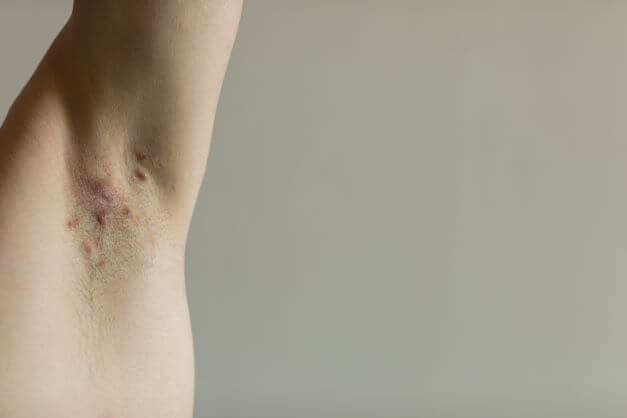Many people are aware of and can recognize skin conditions, even those that are uncommon. Hidradenitis suppurativa is a skin condition that is relatively common. It impacts about 4% of people in the U.S., but few people have ever heard of it before they develop this painful, chronic skin condition. According to Dr. Roopal Bhatt of U.S. Dermatology Partners in Austin, Texas, “Hidradenitis suppurativa is a fairly common, chronic skin condition that typically develops during puberty and can cause serious skin health concerns like infection and scarring. Because early diagnosis and intervention are so important to minimize the negative impact of hidradenitis suppurativa, dermatologists and healthcare providers must work to raise awareness about the warning signs of this skin condition and how it impacts an individual’s skin health and overall wellbeing.” In this blog, Dr. Bhatt will review the basic information about the symptoms of and risk for hidradenitis suppurativa and the recommended treatments for this painful skin condition.
What Is Hidradenitis Suppurativa?
Hidradenitis suppurative is a chronic skin condition that occurs when hair follicles become blocked. This blockage causes large, painful lumps to form under the skin. Hidradenitis suppurativa usually occurs in areas where the skin rubs together like the underarms, groin, buttocks, and breasts, or parts of the body that are very oily around the hair follicles. According to Dr. Bhatt, “Pretty much anyone can develop hidradenitis suppurativa, but it’s most common among young women between the ages of 14 and 40. This is especially true for women who have relatives who struggle with hidradenitis suppurativa flare-ups.”
What Causes Hidradenitis Suppurativa?
When it comes to the underlying cause of hidradenitis suppurativa, Dr. Bhatt says, “We know that it develops when hair follicles become clogged, but there’s no known underlying cause of this skin condition.” While determining a specific cause requires additional research, many risk factors increase the chances that an individual will develop this skin health issue, including:
- Age – Most people develop this condition during or after puberty, and it can continue into adulthood. In many cases, the condition increases in severity over time.
- Gender – Women are significantly more likely to develop this skin condition than men.
- Genetics – Having one or more family members who suffer from this condition makes people much more likely to develop hidradenitis suppurativa.
- Lifestyle and health factors – Tobacco use, obesity, acne, arthritis, diabetes, and inflammatory bowel disease among other lifestyle and health factors can increase the risk for developing this condition and make flare-ups more severe.
What Are Common Hidradenitis Suppurativa Symptoms?
According to Dr. Bhatt, “Hidradenitis suppurativa may develop in one or more areas of the body, and the symptoms can vary in severity. People who have a family history of this condition should become familiar with the symptoms, so they can receive a diagnosis and begin treatment in the earliest stages when this condition is the most treatable.” Some of the common warning signs of hidradenitis suppurativa include the following:
- Blackheads that develop in pitted areas of the skin.
- Small, painful lumps that form under the skin. These lumps can last for several weeks or even months.
- Over time, the bumps may grow larger and break up, oozing pus. This discharge often has a foul odor.
- In most cases, people develop one lump. Then, more form in the same area. Eventually, tunnels may develop that connect the lumps beneath the skin. When this occurs, the affected area is extremely sensitive and painful. It may seep blood and pus, and the wounds may be very difficult to heal and be less responsive to treatments.
You should begin working with a dermatologist for treatment as soon as you notice the warning signs of hidradenitis suppurativa, but it’s especially important to seek professional treatment when this condition is extremely painful, impedes movement, doesn’t improve within a few weeks, develops in more than one area, or frequently flares up.
How Do You Treat Hidradenitis Suppurativa?
When it comes to treating hidradenitis suppurativa, Dr. Bhatt encourages patients to set appropriate expectations saying, “There is no cure for hidradenitis suppurativa, so treatments are about managing symptoms and reducing flare-ups. Most importantly, treatment helps to manage any pain or discomfort and improve wound healing.”
The most common recommended treatments for this skin condition include:
- Topical antibiotics to prevent infection and encourage wound healing.
- Oral antibiotics to manage more severe or widespread infections.
- Steroids injected into the sores can help to reduce swelling and inflammation.
- Oral or topical pain relievers may be recommended to decrease discomfort during flare-ups.
- Hormonal methods of control may be prescribed to help reduce the frequency and severity of flare-ups.
- Biologics may be used to change the way the immune system responds during a flare-up.
- Retinoids like acitretin and may be used in addition to other treatments to reduce the severity of flare-ups and decrease the risk of developing a new flare-up.
- Laser therapy may be used to address individual hidradenitis suppurative sores or permanently remove hair in areas that are prone to flare-ups.
- Surgery may be recommended to expose tunnels between lumps, drain infected sores, or remove the skin in the affected area in hopes of improving the skin’s ability to heal thoroughly. Depending on the extent of surgical intervention, skin grafting may be required following surgery.
Can Hidradenitis Suppurativa Flareups Be Prevented?
According to Dr. Bhatt, “It’s important to manage symptoms and prevent flare-ups of hidradenitis suppurativa. Sometimes this condition will flare up despite best efforts, but there are some simple preventive steps you can take, including managing weight, wearing breathable and moisture-wicking clothing, keeping skin cool and free from moisture, and limiting time spent in hot, humid environments.”
The U.S. Dermatology Partners Team Is Here to Help
If you’re struggling with a hidradenitis suppurativa flare-up or you want to develop a skin care plan to reduce your risk for flare-ups, it’s time to get started working with the knowledgeable dermatologists at U.S. Dermatology Partners. You can request an appointment any time by filling out our online scheduling request form. Once we receive your request, we’ll be in touch to answer your questions and finalize the details of your visit.
Find a location near me
or


